Last Updated on January 9, 2024 by Greg Gillson
I’ve put this resource together for you to answer your question: What birds are in my backyard in Nevada?
This article lists and discusses the identification of the most common birds in your backyard. The birds chosen in this article are compiled from actual data from the citizen science program eBird. Thus, it is more accurate than some other similar articles you may find on the web. I provide pictures of each bird species mentioned and I’ll tell how to attract them to your backyard.
These are the most common backyard birds in Nevada:
- Mourning Dove
- House Finch
- White-crowned Sparrow
- American Robin
- Yellow-rumped Warbler
- Northern Flicker
- Red-winged Blackbird
- Rock Pigeon
- Lesser Goldfinch
- European Starling
- Eurasian Collared-Dove
- Great-tailed Grackle
- House Sparrow
- Verdin
- Song Sparrow
- Northern Mockingbird
- Dark-eyed Junco
- Say’s Phoebe
- Bewick’s Wren
- Spotted Towhee
- Gambel’s Quail
- Brewer’s Blackbird
- Ruby-crowned Kinglet
- Black-billed Magpie
- Anna’s Hummingbird
- California Scrub-Jay
- Brown-headed Cowbird
- Western Kingbird
Nevada Birds and Birding in Nevada State
eBird lists over 445 types of birds as occurring in the state of Nevada.
The most common bird in Nevada: the most frequently seen bird in the state is Mourning Dove. It is reported on 33% of bird watching lists.
If you are serious about knowing the birds native to Nevada, then check out eBird for Nevada. It has recent sightings and photos, illustrated checklists with weekly abundance bar charts for state, counties, and individual hotspots of the best birding locations.
If you want to know about other people interested in birds in your area, join a local bird group. The American Birding Association maintains a list of bird watching clubs for each state.
Nevada Bird Identification
This section is the species accounts. These are designed to help you to recognize birds you see in your backyard. I have used eBird to select the birds that are most common. “Common” means the birds seen most often throughout the year, not necessarily the most numerous.
Each species account starts with a photograph. In the identification section I am using size and shape and bill type before considering the color or patterns on the birds. I find these more reliable when trying to identify an unknown bird. Pay attention to body and tail shape and especially bill shape of birds you see, not just plumage color.
In the section on bird feeders and foods I tell how to attract each species. Not all types of backyard birds will come to feeders. But all backyard birds can be attracted with water. So don’t forget to add a birdbath to your bird feeding station.
Do you live in Northern Nevada? Southern Nevada?
To appear in this article, most birds are widely distributed throughout the state and are often year-round residents. However, for those birds that are more localized in place or time, I list the general region and seasonality. Please see the section following these species accounts for the lists of common species by season.
Even if a species is found in a general area, they occur only in the habitat they prefer. So, the exact habitat of your neighborhood is important for the presence of absence of certain kinds of birds.
1. Mourning Dove (Zenaida macroura)
Mourning Doves are the most widespread and most frequent backyard bird in the Lower 48 states of the United States.
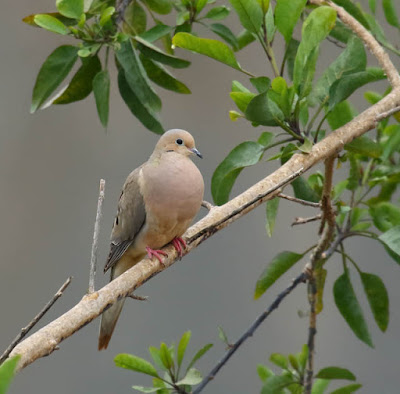 |
| Mourning Dove. Greg Gillson. |
Range in Nevada: Mourning Doves are year-round residents throughout Nevada.
Identification: This is a key species for comparing with an unknown bird.
Size: About 12 inches long from bill tip to tail tip. About same size as Northern Flicker. Larger than American Robin. Slightly smaller than domestic city pigeon.
Shape: Very plump with a small round head. Tail is long and pointed. Legs are short.
Bill: Small and rather slender.
Color: Pale brown-pink body, darker wings and tail. White edges on side of tail.
Habitat, range & behavior: Semi-open areas such as urban areas, farmlands, woods. Often seen perched on wires, fences.
It is a resident across the lower-48 states and Mexico, with some movement out of northern areas in winter.
Their mournful cooing is a familiar spring birdsong.
Food and feeder preference: Mourning Doves eat seeds almost exclusively. Attract with black oil sunflower seeds on a large sturdy tray feeder or on the ground.
2. House Finch (Haemorhous mexicanus)
Originally a bird of the West, now found across most of the US. There are other red finches, but these are the ones most likely in residential areas.
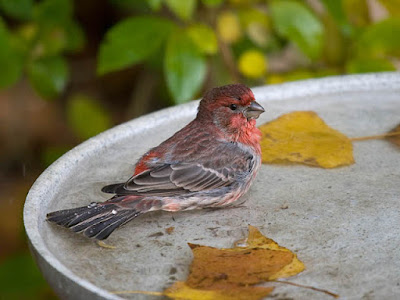 |
| House Finch. Greg Gillson. |
Range in Nevada: House Finches are year-round residents throughout Nevada.
Identification: This is a key species for comparing with an unknown bird.
Size: About 6 inches from bill tip to tail tip. Larger than goldfinches and chickadees. Smaller than a White-crowned Sparrows or Spotted/Eastern towhees.
Shape: Medium build with a medium-long notched tail. Round head.
Bill: Short, conical.
Color: Brown and gray above with streaks on the sides of the pale underparts. Males with red (sometimes orange or rarely yellow) crown, chest, rump.
Habitat, range & behavior: You’ll find small flocks on wires, in short tree tops and in bushes. Originally deserts and grasslands. Rural areas and towns are where they’re now most common.
Formerly found in the western United States and Mexico. Then introduced into the northeastern United States, but now found in nearly all of the lower-48 states and extreme southern Canada. Rare in plains states (Dakotas to Texas) and southern Florida.
House Finches are not territorial, but males sing throughout the year–a lively, wiry song ending in a couple of buzzy notes.
Food and feeder preference: They love sunflower seeds and tube feeders. May eat from thistle socks.
You may like my in-depth article on attracting House Finches.
3. White-crowned Sparrow (Zonotrichia leucophrys)
A common winter visitor in California and resident along the coast and in the higher mountains.
 |
| White-crowned Sparrow. Greg Gillson. |
Range in Nevada: White-crowned Sparrows are year-round residents in northern Nevada, winter visitors in southern Nevada.
Identification: This is a key species for comparing with an unknown bird.
Size: About 7 inches. A large sparrow near size of Spotted/Eastern towhee. Larger than House Finch. Smaller than Starling or Red-winged Blackbird.
Shape: Longer plump body, round head, long tail.
Bill: Short and conical.
Color: Brown back, wings, tail, gray under parts, black-and-white striped crown. For their first year immature birds have tan and reddish-brown striped crowns.
Habitat, range & behavior: Open and shrubby areas.
Coastal form in California at edge of sand dunes. Common winter form in California breeds on Arctic tundra. Various forms breed across the Arctic Canada and Alaska and in mountains in western Canada and the United States.
They sing in spring migration as they move northward. Different populations have slightly different songs.
Food and feeder preference: Weed seeds, grain, insects. Eat black oil sunflower seeds and other seeds on hopper and tray feeders.
4. American Robin (Turdus migratorius)
This familiar bird is a resident in the northern half of the United States and a winter visitor in the southern half.
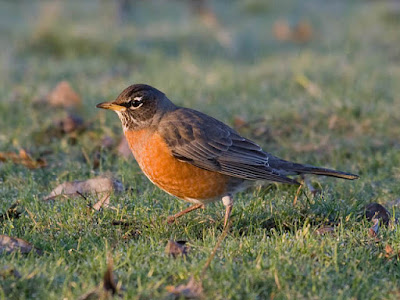 |
| American Robin. Greg Gillson. |
Range in Nevada: American Robins are year-round residents throughout Nevada.
Identification: This is a key species for comparing with an unknown bird.
Size: 10 inches long from bill tip to tail tip. About the same size as a Blue Jay or one of the Scrub-Jays. Larger than Red-winged Blackbird. Smaller than a Mourning Dove.
Shape: Very plump with a fairly long tail.
Bill: Straight and fairly slender, curved at the tip.
Color: Gray-brown upperparts, rusty orange breast.
Habitat, range & behavior: Open woodlands, farmlands, urban parks and lawns.
Migratory, breeds north across Alaska and Canada. Resident in most of the United States (lower 48). Winters in the United States, Mexico, to central America.
Hops on your lawn turning head this way and that looking for food. Their caroling song is one of the early signs of spring in the north.
Food and feeder preference: Worms and other invertebrates in the lawn. May eat fruit from a tray feeder or the ground. Eat small berries from trees and bushes.
5. Yellow-rumped Warbler (Setophaga coronata)
An abundant winter visitor in the West to tree tops and weedy areas.
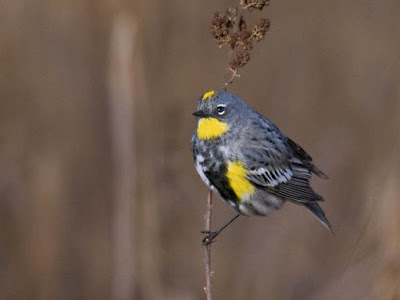 |
| Yellow-rumped Warbler. Greg Gillson |
Range in Nevada: Yellow-rumped Warblers are summer residents throughout Nevada, year-round residents in southern Nevada.
Identification:
Size: Small, they are a bit larger than chickadees and goldfinches. They are smaller than House Finches and juncos.
Shape: Plump and neckless with a shorter tail.
Bill: Short, slender, straight, pointed.
Color: Breeding plumage in spring is blue-gray on the upper parts, black sides and chest, yellow rump, yellow on sides. Two forms: western form with yellow throat and large white wing patch; eastern and northern form with white throat and two white wing bars. In winter plumage both forms are gray brown above, pale cream below. Yellow rump and white tail corners in flight.
Habitat, range & behavior: In breeding season mostly in coniferous or mixed forests, in mountains in west. In winter open areas with fruiting shrubs and scattered trees.
Breed across Canada and Alaska and in conifer forests in the west. Winter along both coasts and the southern states through Middle America. There are also non-migratory forms in Mexico and Guatemala.
They tend to forage in outer branches about half way up the tree.
Food and feeder preference: Mainly insects in the summer, they switch to waxy berries and fruit in winter. They are thus able to winter farther north than other warblers. They are attracted to suet feeders.
6. Northern Flicker (Colaptes auratus)
Of all the bird identification questions I get asked, this common larger backyard bird is the bird most people ask about. It doesn’t occur to those unfamiliar with it that this could be a woodpecker.
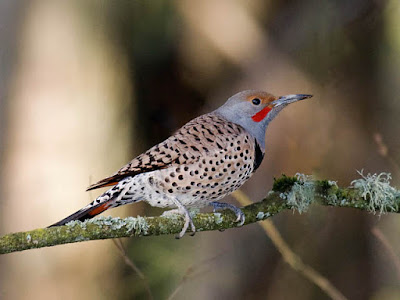 |
| Northern Flicker. Greg Gillson |
Range in Nevada: Northern Flickers are year-round residents throughout Nevada.
Identification:
Size: About the size of a Mourning Dove. Larger than a robin.
Shape: Stocky with short legs, short tail, big head.
Bill: As long as head, thin, slightly curved.
Color: Back is brown with black bars. Under parts pinkish with black spots. Undersides of black wing and tail feathers are bright salmon red (West) or yellow (East). Head gray (West) or brown (East) and males with red (West) or black (East) whisker marks and nape marks (East). Black crescent across chest. White rump seen in flight.
Habitat, range & behavior: Found in woodland edges and forests.
Year-round resident from extreme southern Canada, across all of the lower-48 states and in the mountains of Mexico and Middle America. In summer breeds northward well into Canada and Alaska.
Frequently noted hopping on ground pecking in the ground for insects. In late spring, males proclaim their territory by rapid pounding on a hollow tree branch, though the ringing of metal downspouts at dawn is louder and carries much farther, to the exasperation of anyone trying to sleep inside!
Food and feeder preference: Ants and beetles are their primary foods. Will eat black oil sunflower seeds and are attracted to suet.
7. Red-winged Blackbird (Agelaius phoeniceus)
These noisy flocking birds are most often found in marshes. But in winter they are found in backyards.
 |
| Male Red-winged Blackbird. Greg Gillson. |
 |
| Female Red-winged Blackbird. Greg Gillson. |
Range in Nevada: Red-winged Blackbirds are year-round residents throughout Nevada.
Identification: This is a key species for comparing with an unknown bird.
Size: About 8-3/4 inches long from bill tip to tail tip. About the size of a Northern Cardinal. Smaller than an American Robin.
Shape: Pot-bellied with a longer bill and flat forehead. Tail average.
Bill: Long and sharp pointed.
Color: Males are black with red and yellow shoulder patch. Females are streaked brown and rusty (sparrow-like but pointed bill and flat forehead).
Habitat, range, and behavior: Cattail marshes and wetlands are their summer habitat. In winter they feed in grain fields.
They breed across most of the North American continent. In winter they withdraw from most of Alaska and Canada.
They are found in colonies in summer and large flocks in winter.
Food and feeder preference: They eat insects in summer. In winter they eat grain and seeds. They visit feeders, more often in large winter flocks, and eat most seeds and suet.
8. Rock Pigeon (Columba livia)
These pigeons are especially common in urban settings. They are also known as Rock Doves or domestic pigeons.
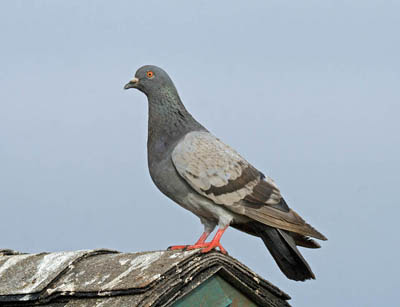 |
| Rock Pigeon. Greg Gillson. |
Range in Nevada: Rock Pigeons are year-round residents throughout Nevada.
Identification:
Size: Larger than a Mourning Dove.
Shape: Large chest. Small round head. Pointed wings. Squared tail.
Bill: Short and fairly thin, with bump on nostril.
Color: Variable; may be white, rusty, or pied. “Wild” coloration has a blue-gray body with iridescent sheen on throat. Paler gray wings with two dark broad wing bars. Tail with dark band. White rump.
Habitat, range, & behavior: City streets, building ledges, and commercial parking lots; farms.
Resident across Canada, all of the United States, south into Mexico. Worldwide distribution.
Often seen perched on roofs and ledges in cities. Walk on sidewalks picking up scraps of food garbage dropped by humans.
Food and feeder preference: Eat grain and corn, and human food scraps, especially French fries and other fast food garbage. May eat just about any food at platform and larger hopper feeders.
9. Lesser Goldfinch (Spinus psaltria)
This bird replaces American Goldfinch in drier parts of the southwestern US.
 |
| Lesser Goldfinch. Greg Gillson. |
Range in Nevada: Lesser Goldfinches are summer residents throughout most of Nevada, year-round residents in southern Nevada.
Identification:
Size: A small bird. Slightly smaller than American Goldfinch, but close.
Shape: Big head, neckless, short forked tail.
Bill: Short, small, conical.
Color: Green back, yellow underparts including under tail coverts. Black wings and tail with white marks. Male with black cap on forecrown. Keeps the same bright yellow plumage year-round, unlike American Goldfinch.
Habitat, range & behavior: Open scrubby woodlands of oak or other trees, fields, grasslands.
Found in the western and southwestern US, into the Great Basin in summer. Found southward to Middle America.
They sometimes gather into flocks of hundreds to feed in weedy fields.
Food and feeder preference: Lesser Goldfinches eat mostly thistle seeds, some insects. At your feeder they will eat black oil sunflower seeds at a tube feeder, but prefer Niger seeds in a “thistle sock” feeder.
10. European Starling (Sturnus vulgaris)
Introduced to North America in the late 1800’s, they crossed the continent, often to the detriment of native cavity-nesting birds. The prime example of an invasive species.
 |
| European Starling. Greg Gillson. |
Range in Nevada: European Starlings are year-round residents throughout Nevada
Identification:
Size: About the size of a Red-winged Blackbird. Smaller than an American Robin. Larger than a White-crowned Sparrow or Spotted/Eastern towhee.
Shape: Stocky with large head, short square-ended tail. Longer legs.
Bill: As long as head. Sharp pointed. Yellow in spring, otherwise dark.
Color: They are grayish brown much of the year, with glossy iridescence and white spotting during the spring.
Habitat, range & behavior: Lowland birds that need trees large enough for nest cavities but plenty of open area for feeding. They are most abundant in urban and suburban areas where they find food and artificial nest cavities.
Resident from coast-to-coast from southern Canada to northern Mexico. In summer north across Canada and Alaska. Native range is Europe to Pakistan, north Africa.
Often viewed as a pest, starlings often bully other backyard birds, taking over bird feeders, and stealing nest cavities from smaller native birds.
In winter they can form into flocks of tens of thousands.
Food and feeder preference: European Starlings eat primarily insects when available, often feeding on the ground. Discourage them from your backyard hopper and tray feeders by never feeding birds table scraps (including bread or meat). They have weak feet and do not perch well on tube feeders. A cage mesh around smaller hopper feeders may keep them out.
11. Eurasian Collared-Dove (Streptopelia decaocto)
These large pale pigeons have only been in the United States since invading Florida in 1983. But they have taken over much of the continent.
 |
| Eurasian Collared-Dove. Greg Gillson. |
Range in Nevada: Eurasian Collared-Doves are year-round residents throughout Nevada.
Identification:
Size: Large pigeon. Larger than Mourning Dove. Same size as domestic pigeon.
Shape: Full plump breast. Round head. Long square tail.
Bill: Small, blunt.
Color: Cream-colored, may be slightly warmer brown on back or, conversely, may be nearly white. Black hind neck mark. Broad white band at end of tail. From underneath when perched on wire, note the black base to the underside of the tail.
Habitat, range & behavior: These pigeons are found in residential areas and farmlands. Look for them perched on electric lines or in trees.
They are year-round residents in residential areas throughout almost all of the United States, except rare in the Northeast.
A pair of birds nest in one area nearly year-round, then build in numbers over a couple of years. Then several birds from the group fly up to 500 miles and set up a new colony. In this way this species took over much of Europe in the last century, and most of North America, starting from Florida in 1983 (from birds escaped from or vagrant in Bahamas).
Food and feeder preference: Eat grain. Will eat all seeds at bird feeders. Large, hungry, and often visit feeders in groups.
12. Great-tailed Grackle (Quiscalus mexicanus)
A big, noisy bird often found near water and in urban landscapes.
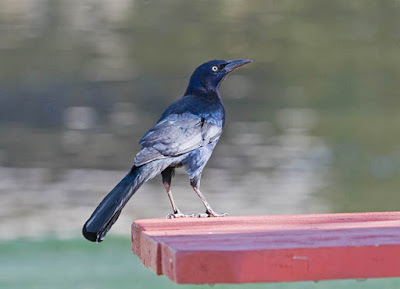 |
| Great-tailed Grackle. Greg Gillson |
Range in Nevada: Great-tailed Grackles are year-round residents in southern and western Nevada.
Identification:
Size: Large bird. Males about the size of a crow; females smaller but still as large as a Mourning Dove.
Shape: Long and slender with a big full tail.
Bill: Long, pointed, stout.
Color: Glossy black with purplish highlights. Females browner.
Habitat, range & behavior: Shorelines, golf courses, agricultural areas, urban centers.
Found in southern portions of West and Midwest US south through Central America. Forage on the ground. Social and loud, with squeaky calls and whistles.
Food and feeder preference: Omnivorous–insects, fruits, human food scraps. To keep these obnoxious birds away from your feeders never feed birds human food wastes.
13. House Sparrow (Passer domesticus)
Like the starling, this is another bird introduced from Europe in the 1800’s. This sparrow is commonly found in cities and farmlands. It is considered a pest in most areas where it has been introduced.
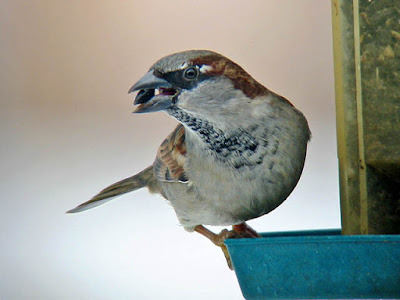 |
| House Sparrow. Greg Gillson |
Range in Nevada: House Sparrows are year-round residents throughout Nevada.
Identification:
Size: The size of a House Finch or Dark-eyed Junco.
Shape: Chunkier than native North American sparrows with large head, barrel chest, short neck, medium tail, short legs.
Bill: Short, conical.
Color: Males are brown and gray with a black mask. Females lack the black and are tan and brown with a pale line back from the eye.
Habitat, range & behavior: Cities and farms.
Range in North American from southern Canada through Central America. In summer northward through Canada to southern Alaska. Originated in Middle East and spread to most of Europe and Asia. Introduced in South America, Africa, Australia–nearly anywhere there are people and cities.
They tend to be messy… and have a good appetite, and may occur in large noisy chirping flocks. They are aggressive toward other feeder birds.
Food and feeder preference: They eat grain, seed, and insects. To discourage them from your hopper and tray feeders do not feed birds human food scraps. They have a bit of difficulty eating from tube feeders.
14. Verdin (Auriparus flaviceps)
This relative of the chickadee is common in desert habitats in the SW United States.
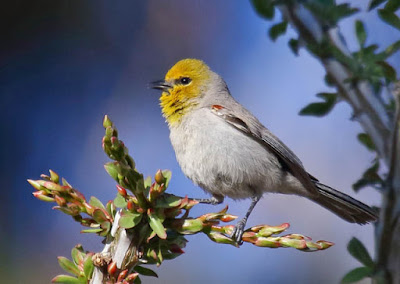 |
| Verdin. Greg Gillson |
Range in Nevada: Verdins are year-round residents in southern Nevada.
Identification:
Size: Very small. Just a bit smaller than a chickadee.
Shape: Plump with a medium length rounded tail.
Bill: Short. Straight. Stout.
Color: All gray with a yellow face.
Habitat, range & behavior: Found in desert scrub and thorny shrubs.
California to Texas and south into northern Mexico.
Forages actively on limbs and tips of vegetation in manner of a chickadee.
Food and feeder preference: They eat primarily insects off of shrubbery. They are not attracted to seed feeders nor have they been documented to drink fresh water! They may drink sugar water from oriole nectar feeders.
15. Song Sparrow (Melospiza melodia)
A common bird, but variable, and similar to many other streaked brown sparrows.
 |
| Song Sparrow. Greg Gillson. |
Range in Nevada: Song Sparrows are year-round residents throughout Nevada.
Identification:
Size: A smaller bird, similar in size to House Finch and juncos. Larger than chickadees and goldfinches. Smaller than White-crowned Sparrows or Spotted/Eastern towhees.
Shape: Plump with round head, long rounded tail.
Bill: Short, conical.
Color: Highly variable in darkness and color saturation across its range (dark rusty to pale gray). Generally gray-brown above with dark brown streaking on back. Complicated head pattern. Streaking on sides and breast converge into dense central breast spot.
Habitat, range & behavior: Thickets, especially near water. Backyard shrubbery.
Resident in western United States, western Canada, coastal southern Alaska, northeastern US. In summer also moves into mid-Canada and northern half of US. In the winter found in most of the US lower-48. Also a population in central Mexico.
Forages on ground, never far from low cover to which they fly if startled.
Food and feeder preference: Song Sparrows feed on seeds and insects near the ground. Will visit hopper and tray feeders for mixed bird seed.
16. Northern Mockingbird (Mimus polyglotos)
This bird sings from exposed perches most of the year and often through the night. They have an unending supply of their own unique short phrases that they repeat about 3 times each, but frequently intersperse songs of other birds.
 |
| Northern Mockingbird. Greg Gillson. |
Range in Nevada: Northern Mockingbirds are year-round residents throughout Nevada.
Identification:
Size: The length of an American Robin.
Shape: Slender and long-tailed. Long legs.
Bill: Medium length, slender, slightly curved.
Color: Gray, darker above, with white patches in wing and tail.
Habitat, range & behavior: They prefer edge habitat with scattered trees and bushes, parks and residential areas.
They are found in eastern and southern parts of the US, West Indies, and south into Mexico.
They boldly defend their nests from other birds, cats, and intruders.
Food and feeder preference: Northern Mockingbirds eat insects, berries, and fruit. You may attract mockingbirds to your feeder with grapes, raisins, apple slices. They will come to a suet block. They readily use a bird bath.
17. Dark-eyed Junco (Junco hyemalis)
Colloquially called “snowbirds,” they often arrive in backyards in winter from nearby mountain forests or more northern climes.
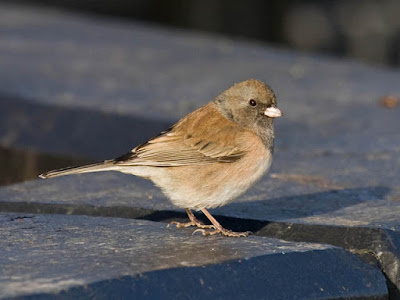 |
| Dark-eyed Junco. Photo by Greg Gillson. |
Range in Nevada: Dark-eyed Juncos are year-round residents throughout most of Nevada.
Identification:
Size: Small birds about the size of a House Finch.
Shape: Round body, short neck, round head, fairly long square-ended tail.
Bill: Short, pointed, conical, pink.
Color: Eastern birds are a darker all-gray with white belly. Western birds (those breeding in California and pictured above) have jet black hood over head, brown back, white belly and pink sides. Females paler.
Habitat, range & behavior: Breed in coniferous forests. Winters widely. Avoids heavy brush, preferring widely spaced bushes.
Breeds across most of Canada, Alaska, and the western half of the United States. Winters from southern Canada and all of the lower 48-states to extreme northern Mexico.
Spend much of their time hopping and feeding on the ground.
Food and feeder preference: Dark-eyed Juncos eat mostly seeds, also insects in summer. Readily feed at backyard feeders on mixed seeds on hopper or tray feeders and ground.
You may like my in-depth article on attracting Dark-eyed Juncos.
18. Say’s Phoebe (Sayornis saya)
This western flycatcher is often found around ranches and canyons.
 |
| Say’s Phoebe. Greg Gillson. |
Range in Nevada: Say’s Phoebes are summer residents throughout Nevada, year-round residents in southern Nevada.
Identification:
Size: About the size of a White-crowned Sparrow. Larger than a House Finch, smaller than a Red-winged Blackbird or European Starling.
Shape: Large partially crested head, upright posture, long full tail.
Bill: Rather small and flat. Black.
Color: Upper parts are gray-brown. Under parts are cinnamon. Tail dark.
Habitat, range, and behavior: Found in dry, open country, grasslands, deserts.
Year-round resident in Mexico and the Southwest. Summers widely in the West and Great Plains to Alaska. Winters more widely in Southwest and Mexico.
Perch on roofs, fence lines, small trees, or ground and chases insects low to the ground.
Food and feeder preference: Eat insects. Do not come to feeders.
19. Bewick’s Wren (Thryomanes bewickii)
This is a brush-loving bird that may hide in your backyard hedges.
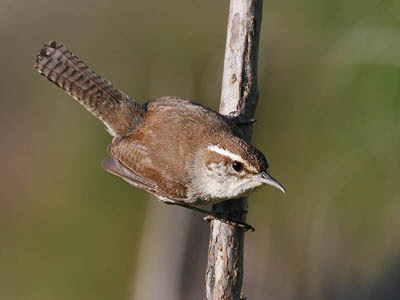 |
| Bewick’s Wren. Greg Gillson. |
Range in Nevada: Bewick’s Wrens are year-round residents in southern and western Nevada.
Identification:
Size: These are fairly small birds, about the size of House Finches.
Shape: They are rather stocky, with short neck, long floppy tail, fairly long legs.
Bill: Long, thin, slightly curved.
Color: Different populations can be more gray or more brown. Barred brown and black tail. Pale gray under parts. The white eyebrow is diagnostic.
Habitat, range, and behavior: These birds are found in brushy tangles, chaparral, backyard bushes.
These birds live along the West Coast from southern British Columba southward into Mexico, the Southwest, east to Missouri.
They stay hidden in dense brush except in spring when they sing loudly from exposed perches.
Food and feeder preference: Bewick’s Wrens eat primarily insects and invertebrates. They will come to feeders in winter for suet.
20. Spotted Towhee (Pipilo maculatus)
Look for this bird scratching in the leaf litter under bushes at the edge of your yard.
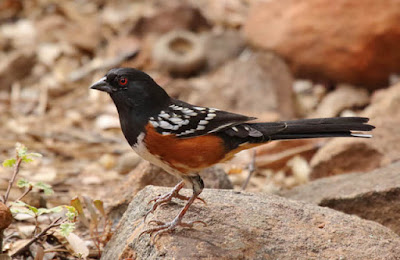 |
| Spotted Towhee. Greg Gillson. |
Range in Nevada: Spotted Towhees are year-round residents throughout most of Nevada.
Identification:
Size: A large sparrow, slightly larger than a White-crowned Sparrow. Larger than a House Finch. Smaller than a starling.
Shape: A plump, large-headed sparrow with a full rounded tail.
Bill: Short, pointed, conical.
Color: Black above including hood. Variable number of white spots on back and wings depending upon location. White tail corners. White belly. Rusty orange sides. Red eye. Females paler, more brownish.
Habitat, range & behavior: Found in brushy areas, chaparral, mountain forest understory.
Found throughout the western half of the United States, mountains of Mexico. In summer to southwestern Canada. In winter to Texas.
They scratch for food on the ground, turning over leaf litter under bushes.
Food and feeder preference: Spotted Towhees eat insects, seeds, and berries. At your birdfeeder will eat seeds on ground or platform feeder.
21. Gambel’s Quail (Callipepla gambelii)
A desert bird that may visit backyards on the edge of town.
 |
| Gambel’s Quail. Greg Gillson |
Identification:
Size: Actually, only as long as an American Robin. Shorter, bill to tail, than Mourning Dove, though much differently shaped.
Shape: Round and plump with strong breast and legs. Relatively small head. Short tail.
Bill: Short, stout. Culmen decurved.
Color: Blue-gray chest. Cream belly with dark central patch. Back and tail brownish. Rusty streaked flanks. Chestnut crown. Two ornamental feathers drooping over forehead.
Habitat, range & behavior: Found in brushy and thorny desert scrub.
Ranges in SW deserts from Colorado south to west Texas and California into NW Mexico.
Forage on the ground in flocks. Run from danger.
Food and feeder preference: Nearly all food is plants: seeds, leaves, berries. Mesquite tree pods are a favorite food. They may visit a low platform feeder or seed scattered on the ground. They will eat sunflowers, millet, cracked corn, and are one of a few birds that will eat milo–a common filler seed in cheap birdseed. Will come to water on the ground.
22. Brewer’s Blackbird (Euphagus cyanocephalus)
This blackbird is common in the West.
 |
| Brewer’s Blackbird. Greg Gillson. |
Range in Nevada: Brewer’s Blackbirds are year-round residents throughout most of Nevada, winter visitors only in southern Nevada.
Identification:
Size: The size of a Red-winged Blackbird. Larger than a White-crowned Sparrow. Smaller than an American Robin.
Shape: Well proportioned. Somewhat pot bellied. Long tail. Flatter forehead profile.
Bill: As long as head. Sharp pointed. Straight. Thick base.
Color: Males are shiny black, glossed with purple on head. Females are dull gray.
Habitat, range, and behavior: They like open country, open woods, shores, towns, powerlines.
Resident in the West, also in Great Plains from Great Lakes westward in northern United States and southern Canada. In winter withdraw from Great Plains and winter across the southern United States from Florida to most of Mexico.
Form large flocks in winter. Often found in parking lots near fast food restaurants.
Food and feeder preference: Eat seeds, grain, and insects. Will come to platform feeders or feed on the ground for seeds, suet.
23. Ruby-crowned Kinglet (Regulus calendula)
These tiny little hyperactive balls of feathers are very similar in appearance to sluggish Hutton’s Vireos. Note the yellow feet and skinny black legs of the kinglet.
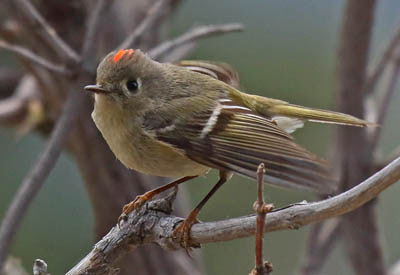 |
| Ruby-crowned Kinglet. Greg Gillson. |
Range in Nevada: Ruby-crowned Kinglets are year-round residents in mountains throughout Nevada, winter residents throughout.
Identification:
Size: Smaller than a chickadee or goldfinch.
Shape: Plump, almost round body with round head merging into the body almost without neck. Very short tail. Thin legs.
Bill: Very short, rather thin.
Color: Olive-green, tending toward gray, especially on the head. Paler yellow-green below. Wing gray with yellow-green edges to the wing feathers. Two white wing bars with distinctive black panel below the lower wing panel. White eye ring slightly broken on top and bottom. Red crown of male only shows when agitated. Legs very thin, black, with obvious yellow soles to the feet.
Habitat, range, and behavior: Mountain conifers in summer, brushy patches and chaparral in winter. Residential landscaping hedges and bushes.
Breeds in Alaska, across Canada, and mountains of the West. Migrates through all of US. Winters in coastal East, Southeast, West, into Mexico.
Active flitting from branch to branch, in interior of bushes and small trees, in short flap-hops. Constantly twitches wings. Hover-gleans at leaf tips.
Food and feeder preference: Ruby-crowned Kinglets feed in bushes next to house looking for spiders and insects. May eat at suet feeder.
24. Black-billed Magpie (Pica hudsonia)
This large flashy bird with a long tail is a ranchland bird in the West. The only similar bird in North America is the Yellow-billed Magpie of the Central Valley of California.
 |
| Black-billed Magpie. Greg Gillson |
Range in Nevada: Black-billed Magpies are year-round residents throughout most of Nevada, absent southern Nevada.
Identification:
Size: About the size of an American Crow, but with a longer tail.
Shape: Thick neck, large head, strong legs. A very long pointed tail: the distance from the base of the tail to the tip of the tail is nearly as long as from the base of the tail to the tip of the bill. Wings are broad and rounded at the tips.
Bill: Stout, nearly as long as head.
Color: Black head, breast, back. White shoulders and belly. Wings black above with bluish or greenish sheen; most of the primaries are white. Tails is blackish with an iridescent blue-green sheen.
Habitat, range & behavior: Magpies are found in dry open country, ranches, farms, scattered open pine lands and riparian thickets.
They are residents from southern Alaska to the Great Basin and Great Plains to the Dakotas and south to New Mexico.
Fly with slow wing beats and deep wing strokes displaying large white wing patches. Social. Perch on fence posts. Forage on ground. Calls are noisy, raspy, querulous “yak?”
Food and feeder preference: Omnivore as crows, eating carrion, berries, seeds, nuts, human garbage, pet food. Birders generally don’t want this species at their bird feeders. Locals often view these birds as pests.
25. Anna’s Hummingbird (Calypte anna)
This big resident hummingbird of the West is everywhere there are people!
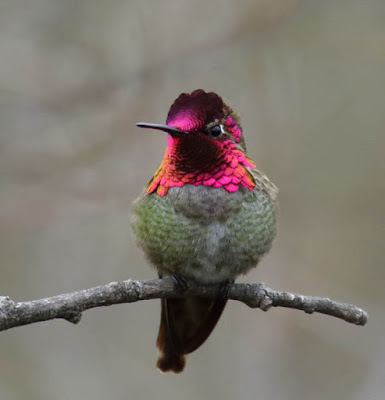 |
| Anna’s Hummingbird. Greg Gillson. |
Range in Nevada: Anna’s Hummingbirds are year-round residents in southern and southwestern Nevada.
Identification:
Size: Slightly larger than widespread hummingbirds like Ruby-throated in the east and Rufous Hummingbird in the west. Smaller than a goldfinch or chickadee.
Shape: Plump, with long wings covering tail. Unmistakable long bill.
Bill: Longer than head, round, slightly downcurved.
Color: Green upper parts, gray under parts with greenish cast on sides. Male with entire head and throat covered in iridescent metallic rose pink. Female usually has pink throat spot.
Habitat, range & behavior: Chaparral, open woods, suburban gardens all host this species.
Formerly only in northern Baja and southern California they expanded to Arizona, and all the way to southern Alaska along the Pacific coast, following plantings of winter blooming flowers and the popularity of placing out hummingbird feeders.
Nest early (December to February), even as they colonize northward and encounter snow in winter.
Food and feeder preference: Nectar and small insects is the main food of Anna’s Hummingbirds. Both are available in flowering plants. Quickly find hummingbird feeders filled with sugar water.
26. California Scrub-Jay (Aphelocoma californica)
This jay, like most jays, is brash and noisy.
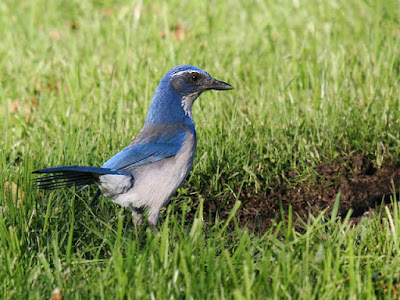 |
| California Scrub-Jay. Greg Gillson. |
Range in Nevada: Western Scrub-Jays are year-round residents in western Nevada.
Identification:
Size: This bird is the size of an American Robin or Northern Mockingbird. They are larger than a European Starling or Red-winged Blackbird. Smaller than a Mourning Dove.
Shape: Strong body, thick neck, big head. Long legs. Fairly long full tail.
Bill: Long, stout, curved near tip.
Color: Deep azure blue upperparts, wings and tail with gray-brown back. Black bill and mask. White under parts with partial blue necklace across chest.
Habitat, range & behavior: Oak woodlands, chaparral, residential areas.
Found along West Coast from northern Baja to Washington state.
They forage on the ground, caching food in fall to save for later winter.
Food and feeder preference: California Scrub-Jays are omnivorous; they eat insects, berries, small animals, bird eggs. At hopper and tray feeders they may harass other birds, and gulp down large quantities of black oil sunflower seeds and peanuts to go bury. Thus, some people put wire mesh cages over their hopper and tube feeders to keep the jays out–smaller birds can get through the mesh.
27. Brown-headed Cowbird (Molothrus ater)
Cowbirds are small blackbirds lay their eggs in the nests of other smaller birds, such as warblers. The adoptive parents raise their young!
 |
| Brown-headed Cowbird. Greg Gillson. |
Range in Nevada: Brown-headed Cowbirds are summer residents throughout Nevada.
Identification:
Size: Larger than White-crowned Sparrows, but smaller than Rose-breasted or Black-headed Grosbeaks. Smaller than other blackbirds, starlings, and grackles.
Shape: Perhaps a little bit pot-bellied. Medium length tail. Flat forehead as typical for blackbirds.
Bill: Rather thick and stout.
Color: Males are glossy black with rich brown head. Females are dusty gray-brown throughout. Long-held juvenile plumage similar to pale female, scaly, being fed by Yellow Warbler or Song Sparrow or a hundred other host species.
Habitat, range & behavior: They are found in woodlands and farms. Also with other blackbirds in winter at shopping center parking lots.
In summer they breed across Canada and most of the United States and Mexico. In winter they move south out of Canada and occupy both coasts and southeastern States in the US.
These small blackbirds join other flocks of blackbirds in cattle feedlots. You may see cowbirds riding on the backs of cattle, sheep, or horses. They originally rode on the backs of American bison on the Great Plains, but expanded when forests were cut.
Food and feeder preference: Cowbirds eat grains, seeds, and insects. They will readily come to hopper and platform feeders. They are larger and more aggressive, so keep other birds from feeders and have a big appetite!
28. Western Kingbird (Tyrannus verticalis)
You may note these birds aggressively and noisily chasing off other birds, such as crows and hawks, from their territories. And other interloping Western Kingbirds, of course.
 |
| Western Kingbird. Greg Gillson. |
Range in Nevada: Western Kingbirds are summer residents throughout Nevada.
Identification:
Size: Larger than phoebes. Smaller than American Robins. The same size as Red-winged Blackbirds.
Shape: Long body with heavy chest. Large head with raised hind crown. Large bill. Long full tail. Upright posture.
Bill: Fairly long, but shorter than head, stout and wide at the base.
Color: Gray head, back, and chest. Yellow belly. Brown wings. Black tail with contrasting white outer tail feathers.
Habitat, range & behavior: Open country.
Summers in the western half of the United States and adjacent southern Canada.
Perches on electric wires, fence lines. Chases flying insects and returns to perch.
Food and feeder preference: Feeds on flying insects. Does not come to feeders.
Common Birds in Nevada
To determine how common each species is I used the data from actual bird sightings from the citizen science program eBird. Birds are listed by frequency. That is, how often the species is recorded on checklists submitted to eBird (a percentage).
When choosing the birds to include in this article I leaned strongly to birds that are present throughout the year in good numbers. Thus, many of the common birds are year-round residents. This means that they live in the same location all year. They raise their young in your neighborhood. They don’t migrate. Or if the species does migrate, the ones living in your area don’t. If this is the case, some migrants may move into your area during certain times of year, adding to the same species that are in your yard full time.
Some migrant birds visit your yard during the “summer.” Often, they arrive in spring and remain until late fall. They nest and raise their young in your neighborhood. These are the summer residents.
Other migrant birds visit your backyard during the “winter.” Some of these winter visitors may arrive in July and remain into April. Others may only be found in the cold of December or January. They key here is that they nest and raise their young somewhere else. They only visit your yard in the non-breeding season.
Migration is an amazing spectacle.
There will be birds that fly through your region in spring or fall (or both). They may visit your backyard only a few days or weeks a year. They aren’t regular enough, or stay long enough, to be included in this article. But the number of briefly visiting migrant birds could double the number of species presented here. You may see them over time. Consult checklists in eBird for your county to see what is possible.
I have generally excluded common waterfowl, birds of prey, shorebirds, seabirds, and others that aren’t usually found in residential areas. But they may certainly fly over or be seen regularly if your home is on a shoreline, for instance.
Most common backyard birds in Nevada throughout the year
The following list is the backyard birds that are, on average, most common throughout the entire year. The list is ordered by most common based on the frequency of how often each species is recorded on checklists submitted to eBird.
- Mourning Dove (33% frequency)
- House Finch (28%)
- White-crowned Sparrow (25%)
- American Robin (22%)
- Yellow-rumped Warbler (22%)
- Northern Flicker (20%)
- Red-winged Blackbird (18%)
- Rock Pigeon (17%)
- Lesser Goldfinch (17%)
- European Starling (17%)
- Eurasian Collared-Dove (15%)
- Great-tailed Grackle (15%)
- House Sparrow (15%)
- Verdin (14%)
- Song Sparrow (14%)
- Northern Mockingbird (14%)
- Dark-eyed Junco (13%)
- Say’s Phoebe (13%)
- Bewick’s Wren (13%)
- Spotted Towhee (12%)
- Gambel’s Quail (12%)
- Brewer’s Blackbird (11%)
- Ruby-crowned Kinglet (11%)
- Black-billed Magpie (11%)
- Anna’s Hummingbird (11%)
Most common backyard birds in Nevada in winter
- White-crowned Sparrow (41% frequency)
- House Finch (31%)
- Northern Flicker (28%)
- Mourning Dove (27%)
- Yellow-rumped Warbler (25%)
- Rock Pigeon (24%)
- European Starling (23%)
- Dark-eyed Junco (22%)
- American Robin (21%)
- Ruby-crowned Kinglet (19%)
- House Sparrow (18%)
- Song Sparrow (18%)
- Lesser Goldfinch (17%)
- Great-tailed Grackle (17%)
- Eurasian Collared-Dove (16%)
- Verdin (16%)
- Red-winged Blackbird (15%)
- Say’s Phoebe (15%)
- Northern Mockingbird (15%)
- California Scrub-Jay (14%)
Most common backyard birds in Nevada in summer
- Mourning Dove (29% frequency)
- American Robin (25%)
- House Finch (19%)
- Brown-headed Cowbird (15%)
- Red-winged Blackbird (15%)
- Spotted Towhee (15%)
- Western Kingbird (14%)
How do common backyard birds in Nevada differ between summer and winter?
Brown-headed Cowbirds, Western Kingbirds are more common in summer than winter.
White-crowned Sparrows, Northern Flickers are more common in winter.
Common Backyard Birds of Las Vegas, Nevada
 |
| Verdin. Greg Gillson |
- Mourning Dove (36% frequency)
- Verdin (34%)
- House Finch (31%)
- Great-tailed Grackle (31%)
- Gambel’s Quail (28%)
- Yellow-rumped Warbler (27%)
- White-crowned Sparrow (27%)
- Northern Mockingbird (24%)
- Say’s Phoebe (20%)
The birds in Las Vegas reflect its Mohave Desert setting. Birds more common in Las Vegas than in the state of Nevada as a whole are Verdins, Great-tailed Grackles, Gambel’s Quail.
Common Backyard Birds of Reno, Nevada
- Mourning Dove (39% frequency)
- American Robin (37%)
- California Scrub-Jay (35%)
- House Finch (35%)
- Lesser Goldfinch (32%)
- Northern Flicker (29%)
- White-crowned Sparrow (28%)
- Steller’s Jay (27%) Learn about this species on eBird
- California Quail (27%) Learn about this species on eBird
- European Starling (26%)
- Mountain Chickadee (25%) Learn about this species on eBird
- Yellow-rumped Warbler (24%)
- Dark-eyed Junco (22%)
- Rock Pigeon (22%)
- House Sparrow (20%)
American Robins, California Scrub-Jays, Lesser Goldfinches, Northern Flickers, Steller’s Jays, California Quails, Mountain Chickadees are more common in Reno than average for the rest of the state.
Wrapping Up
Nevada has many interesting backyard birds and if you wish to explore a little further, you can find other common birds in these environments:
Desert and Grassland Birds:
- Greater Roadrunner (Geococcyx californianus): These iconic desert birds with long legs and a distinctive crest stalk the ground in search of lizards and insects, adding a unique charm to arid landscapes.
- Common Nighthawk (Chordeiles minor): These nocturnal insectivores fill the desert night with their eerie, whip-like chirps and booming “booms” as they fly and hunt for moths.
- Western Meadowlark (Sturnella neglecta): The state bird of Nevada, these yellow-breasted birds with a black V-mark on their chest fill open fields and grasslands with their sweet, whistled songs.
- Horned Lark (Eremophila alpestris): These small brown birds with black head markings inhabit open deserts and grasslands, often seen running and taking flight in short bursts.
- Rock Wren (Salpinctes obsoletus): These lively brown wrens with long bills and white wing bars flit through rocky outcrops and canyons, offering their loud, trilling songs.
Forest and Woodland Birds:
- Clark’s Nutcracker (Nucifraga columbiana): These large, blue-gray birds with black wings and white wing patches are masters of storing and hiding nuts, adding a playful element to mountain forests.
- Steller’s Jay (Cyanocitta stelleri): These bold blue jays with black heads and white wing bars flash through forest canopies, displaying their acrobatic skills and loud, raucous calls.
- Pygmy Nuthatch (Sitta pygmaea): These tiny gray birds with black caps and white undersides flit through conifer branches, searching for insects and seeds.
- Gray Flycatcher (Empidonax wrightii): These small olive-gray flycatchers perch on branches in woodlands, offering their high-pitched “bee-bee-bee” calls.
- Western Bluebird (Sialia mexicana): These vibrant blue birds with orange breasts and white wing bars prefer open woodlands and edges, adding a splash of color to forested areas.
Frequently Asked Questions
What is the state bird of Nevada?
he proud state bird of Nevada is the Western Meadowlark! (Sturnella neglecta) These cheerful yellow-breasted birds with a black V-mark on their chest add a touch of song and beauty to the state’s diverse landscapes, from open fields and grasslands to foothills and valleys.
They were chosen as the state bird in 1925 after a statewide vote involving over 121,000 schoolchildren, beating out the Bobwhite and Northern Cardinal. The Western Meadowlark embodies the spirit of Nevada with its open grassland habitat, sweet whistled song, and resilience. Seeing these beautiful birds soaring and singing in the open plains is a quintessential Nevada experience.

What are the black and white birds in Reno Nevada?
Black-billed magpies are fairly common residents in Nevada, although their distribution varies depending on habitat and elevation. Here are some pointers on where you might encounter these intelligent corvids:
Habitat:
- Open areas: Look for magpies in open fields, grasslands, sagebrush scrublands, and agricultural lands. They prefer landscapes with scattered trees and shrubs for perching and nesting.
- Riparian areas: Magpies frequent waterways and wetlands, where they find food and nesting sites alongside other birds.
- Pinyon-juniper woodlands: In the higher elevations, these woodlands and edges offer suitable habitat for magpies, especially near meadows or open clearings.
- Mountain ranges: While not as common as in lower elevations, magpies can occasionally be found in lower mountainous areas with suitable open spaces.
Locations:
- Western Nevada: Black-billed magpies are more abundant in western Nevada, particularly in valleys and lower foothills. Look for them around Reno, Sparks, Fallon, Carson City, and Winnemucca.
- Northern Nevada: Their range extends into northern Nevada, including areas around Elko, Winnemucca, and Fernley.
- Eastern Nevada: Magpies are less common in eastern Nevada due to drier and more arid environments. However, you might find them near riparian areas or agricultural lands in valleys like the Ruby Valley or Pahranagat Valley.
What is the rare bird in Nevada?
The Phainopepla is not considered common in Nevada. While they are present in the state, they are rather uncommon and sporadic visitors. Their main habitat preferences and breeding grounds lie further south in the southwestern deserts of the United States and northern Mexico.

Here’s a breakdown of their presence in Nevada:
- Distribution: They are primarily found in the southernmost tip of Nevada, particularly in the Mojave Desert region around Las Vegas, Pahrump, and Mesquite. Sightings are much rarer in the northern and central parts of the state.
- Habitat: They are most likely to be encountered in desert washes and riparian areas with dense stands of mesquite, acacia, or mistletoe, their primary food sources.
- Seasonality: Their presence in Nevada is primarily seasonal, with most sightings occurring between late spring and early fall. They migrate south for the winter to their breeding grounds.
- Rarity: Finding a Phainopepla in Nevada is considered a treat for birders. Sightings are infrequent and unpredictable, depending on food availability, breeding success, and other environmental factors.
However, don’t completely rule out the possibility of seeing one! If you’re birding in southern Nevada during the right season and habitat, keep your eyes peeled for these stunning birds with their crested black heads, red eyes, and white wing patches. Their distinctive “hoooeet” call might also alert you to their presence.
Related Articles:
Red, Orange, & Yellow Birds of Nevada
34 of the most common birds in the United States (with photos)








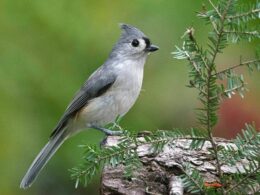


Thank you for this list and especially photos. I have some birds with black backs and brownish yellow breasts in my back yard. They have longish beaks. Any idea what they are?
I'm guessing they are first year or female Yellow-headed Blackbirds?
Can't think of anything else now with the description you gave. But it still doesn't seem like it might be the correct guess.